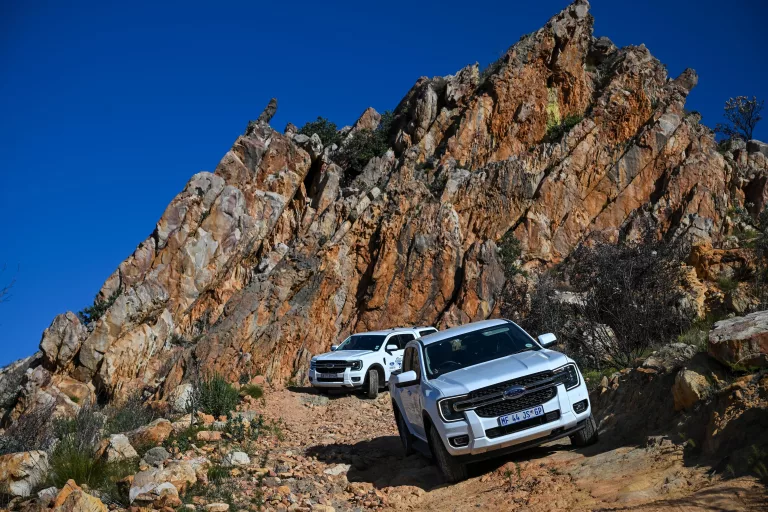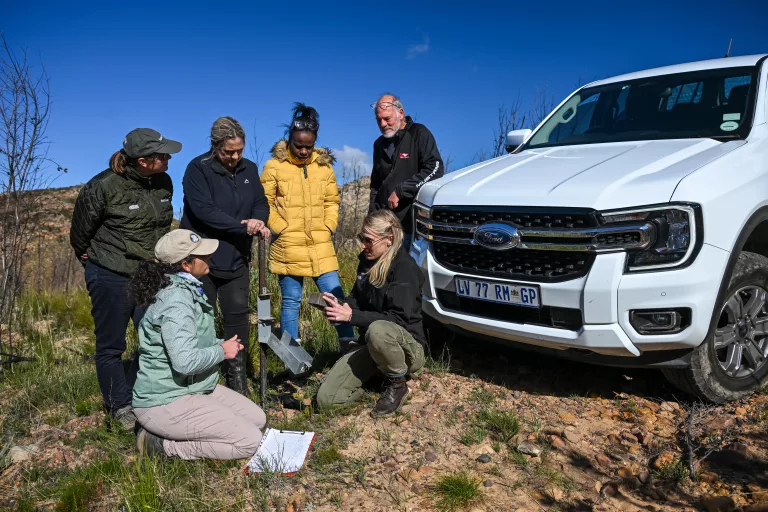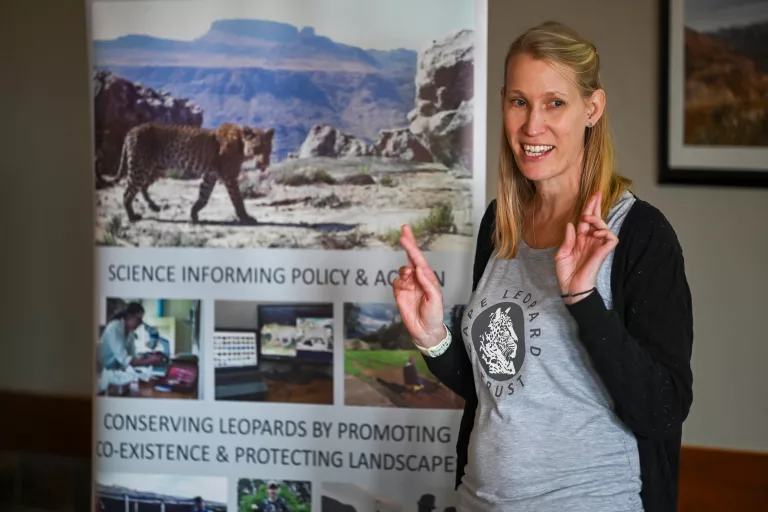In the rugged terrain of Klipbokkop Mountain Reserve near Worcester, conservation work unfolds quietly—but powerfully. This reserve, nestled in the folds of the Cape’s fynbos biome, forms part of an ambitious leopard monitoring project run by the Cape Leopard Trust (CLT), one of South Africa’s leading predator conservation organisations.
Anita Wilkinson and Dr Katy Williams of Cape Leopard Trust/Picture by Rob Till
Supported by the Ford Wildlife Foundation (FWF), the CLT is working to protect these elusive cats through research, community education, and ongoing fieldwork across challenging mountain terrain.
Founded in 2004 to study the Cederberg’s leopard population, the CLT has grown into a respected conservation force underpinned by three central pillars: research, conservation, and environmental education. Over two decades later, its mission continues to evolve as it monitors leopard populations across the broader Boland Mountain Complex.
Accessing the wild, responsibly
Fieldwork in the Cape Mountains is no small task. Access to camera trap sites often means navigating steep inclines, rocky tracks, and remote slopes—conditions that demand reliable, off-road-ready vehicles. Enter the Ford Ranger, supplied by the Ford Wildlife Foundation. Known for its rugged capabilities and durability, the Ranger enables the CLT to transport equipment and researchers to areas that would otherwise be inaccessible.

Ford Ranger going through the terrain/Picture/Rob Till
During a recent visit to Klipbokkop, conditions reflected the often unpredictable Cape weather. While the day began with mild sun, the weather soon turned chilly and overcast, with rain setting in later on the way back to Cape Town International Airport. Despite the climate changes, conservation fieldwork continued seamlessly thanks to the Ranger’s ability to handle shifting terrain and conditions with ease.
Camera traps and critical data

Anita Wilkinson and Dr Katy Williams showing media how they assemble the camera traps/Picture by Rob Till
Senior CLT researcher Anita Wilkinson confirmed ahead of the field visit that leopard sightings are exceedingly rare due to their elusive nature and low population densities. As a result, the team relies heavily on the camera trap network to understand population dynamics.
Camera traps—motion- and heat-sensitive digital cameras—are central to CLT’s research strategy. These devices operate day and night, capturing invaluable data on leopard movements and behaviour. Each leopard is identifiable by its unique rosette pattern, allowing researchers to monitor individual cats over time and estimate population densities.
Observing the placement of camera traps in designated monitoring zones highlighted just how strategic and deliberate the process is. However, the team noted that extreme weather events—such as floods and wildfires—have damaged or destroyed several of these units in the past, leading to significant financial setbacks.
ALSO READ: Bucket-list wildlife experiences you can only have in South Africa
A unique leopard population
Leopards in the Western Cape differ significantly from those found in the savannah. Males in the fynbos biome average around 35kg, with females closer to 20kg—about 50% lighter than their savannah counterparts. These Cape leopards also patrol territories up to ten times larger and occur at much lower densities, fewer than two per 100 km².
While sometimes informally referred to as “Cape leopards,” these animals are not classified as a separate subspecies. All African leopards fall under Panthera pardus pardus, although the Cape population is recognised as a distinct management unit requiring specialised conservation strategies.
These leopards’ continued survival is closely tied to the preservation of the fynbos biome itself. As an apex predator, the leopard serves as an “umbrella species”—protecting its habitat protects countless others.
The hidden threat of snares—and how the public can help

Dr Katy Williams, during a talk to the media / Picture by Rob Till
During the field briefing, Dr. Katy Williams also addressed the growing threat posed by wire snares—crude traps that are often set illegally and indiscriminately. These snares have maimed and, in some cases, killed wildlife, including leopards. They’re not only a conservation concern but a painful reminder of the ongoing risks that even protected species face in the wild.
Public involvement, Dr. Williams explained, is key to addressing the issue. She encouraged nature lovers, landowners, and hikers to stay vigilant:
- If you come across a snare while in the veld, disarm it safely by cutting the wire and report the location to the Cape Leopard Trust.
- Be alert to any suspicious activity in natural areas and report it to authorities or the CLT.
- Farmers and landowners can help by adopting holistic livestock management practices that reduce conflict with predators.
- Driving slowly and attentively in mountainous leopard territory can also help avoid collisions with wildlife.
- Lastly, spreading awareness about the importance of protecting leopard habitat, prey species, and corridors is essential to their continued survival.
Conservation beyond the field
CLT’s work doesn’t stop in the mountains. Education forms a key pillar of the organisation’s approach. From wilderness camps and eco-clubs to school presentations and art competitions, the team actively works to inspire the next generation of conservationists. Their book, Footprints in the Fynbos, available in English, Afrikaans, and isiXhosa, is a vibrant educational resource rooted in local culture and ecology.
Partnership in action
“The Ford Ranger is an essential part of every camera trap survey,” says Dr. Katy Williams, CLT’s Research and Conservation Director. “Researching leopards in the Cape is especially challenging due to their elusive nature and the demanding landscapes we work in. Reliable mobility makes this work possible.”
The Ford Wildlife Foundation currently supports 28 projects across South Africa and Mozambique, spanning conservation, research, and education. “We believe in enabling real-world conservation efforts through practical support,” says FWF manager Lynda du Plessis. “The Cape Leopard Trust is doing scientifically rigorous, community-centred work in some of the country’s most remote areas—and we’re proud to be part of that journey.”
As one of South Africa’s last wild apex predators, the leopard remains both a conservation challenge and a symbol of what’s still possible when science, community, and support align. With the Ford Ranger powering the journey, the Cape Leopard Trust continues to ensure that these cats—and the ecosystems they depend on—have a fighting chance.
Follow us on social media for more travel news, inspiration, and guides. You can also tag us to be featured.
TikTok | Instagram | Facebook | Twitter
ALSO READ: Rare elephant sighting sparks hope in Senegal Park

